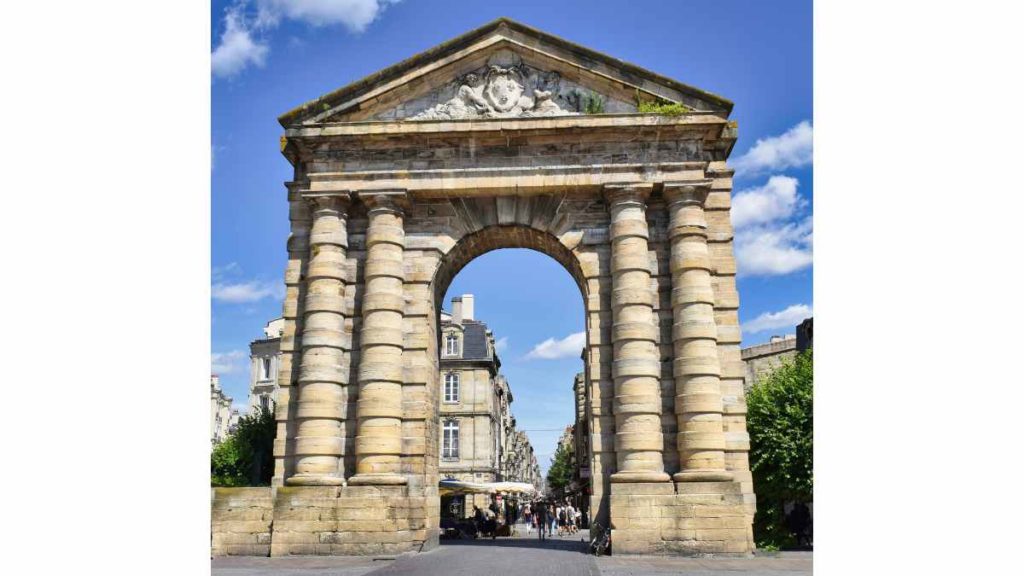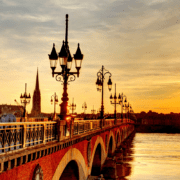
Porte d’Aquitaine, Bordeaux
Built in 1753 and being so named as a sort of homage to the Duke of Aquitaine, who had just been born, the Aquitaine Gate, like many of the other medieval gates of Bordeaux, also has the appearance of a triumphal arch.
It is located in the old Saint Julien square. In fact, it is also known as the Saint Julien Gate. Since 1918, the square was renamed Place de la Victoire.
On one of its sides, it has the coat of arms of Bordeaux and the Great Bell, as well as a leopard. On the other side, it has some sea gods, as well as fleurs-de-lis in relief.
This wonderful gate is part of the 6 medieval gates of the city. We tell you more about them:
The 6 gates of Bordeaux
Bordeaux, besides being a charming and beautiful place, also enjoys a long and very rich history. In case you didn’t know, this city is more than 2,000 years old. As you can imagine, there is much to see from this long past.
During medieval times, like most European cities, Bordeaux was fortified. It was surrounded by an extensive wall and a large number of gates that gave access to the town. However, over time much of the wall was destroyed and with it the gates.
Intendant Tourny, during his period of leadership, designed the construction of new gates. These were part of the project to improve the city in general, where the triumphal arches are a very present feature.
The 6 medieval gates of Bordeaux
The medieval gates of Bordeaux are among its main attractions. In a way, they allow you to take a journey through history and learn more about this fascinating past. So, if you are passing through the city, you must include them in your itinerary.
The first to top the list was the one that introduced this post, but there are 5 more. Here are some of the most important facts you should know about these monuments of great historical value:
Burgundy Gate
It was built between 1750 and 1755 and is also known as the Arc de Triomphe or the Porte de Salinières, which means salt mines. As you may know, this is one of the main goods that were traded in the area for that time.
It is near the Pont Pierre, which for a long time was the only way to cross the Garonne River. This means that this gate was one of the main entrances to the city.
The Burgundy Gate has a large arch, monumental and striking, which goes in connection with other works done at the time. It was directed by the architect Ange-Jacques Gabriel, who at the time was the head of the royal court.
Gate of the Great Bell
This is undoubtedly the most famous Bordeaux gate, as well as being the oldest. The Great Bell, or Grosse Cloche in French, dates from medieval times. Next to the Cailhau Gate, one of the few monuments that remain from this period.
It is located opposite the church of Saint-Eloi, on the road to Santiago de Compostela. In 1886 it was declared a historical monument. It is crowned by a weathervane with an animal figure. For some, it is the leopard of Guyenne. Others say it was part of the heritage of the kings of England during the English period in the city.
Originally, it was incorporated into the walls in the 13th century, undergoing major changes since then. The last ones were made in 2016 as part of a restoration process. Here it is also possible to see a clock dating from 1657.
The original construction had six towers, although currently only two remain. It gives way to the Rousselle district.
The bell it has today is not the original one. According to some experts, it is the sixth to occupy this place. The last one broke in 1774 when it was rung to warn of a great fire. Known as Armande Louis, it is about 2 meters high and weighs 7,750 kilos.
The city’s tourist office offers tours inside the bell. Among other things, it is possible to see the gears that make up the clock mechanism. What few people know is that this building was used as a prison. In fact, you can see the cells with old bars.
Cailhau Gate
Another of the most famous points of the city, as well as the most photographed. The Cailhau Gate is located on the banks of the river, between the Place de la Bourse and the Porte de Bourgogne. Built between 1493 and 1496, it has a height of 35 meters and a really beautiful architecture.
This construction commemorates the victory of Charles VIII in the battle of Fornovo. It has some elements that make it characteristic: its conical roofs or the sculptures of the king, St. John the Evangelist and Cardinal d’Epernay.
On both sides of the gate it is possible to observe some traces of the connection that existed with the wall that surrounded Bordeaux. From here, visitors can enjoy an incredible panoramic view of the area around Bordeaux.
From here, visitors can enjoy an incredible panoramic view of the area of the docks, the stone bridge and the roofs of the city.
Visiting the interior costs 5 € per person. It is open to the public daily in the morning from 10 am to 1 pm and from 2 pm to 6 pm.
Porte de la Monnaie
Developed next to the hôtel de la monnaie , it is located between the Stone Bridge and the San Juan Bridge. It separates the Santa Cruz and Mint piers.
It was built between 1752 and 1758, when Tourny decided to pay a sort of homage to the Mint to give it a greater connection.
Dijeaux Gate
For some, it is a sort of relative of the Aquitaine gate because of the similarities they have in architectural style. In addition, it is also crowned by a triangular pediment. It is located behind the Place de Gambetta, just at the end of Bouffard Street.
It was built by the architect André Portier in 1748. On one of the sides you can see the coat of arms of the city, as well as a leopard. In addition, there are also some marine symbols, bunches of grapes and a cornucopia. There is also a mask that is covered with two animal heads, very similar to goats.
On the other side, there is the triangle which is occupied by some royal symbols, as well as some fleurs-de-lis and a crown, apart from two wings, a fish and a helmet. Finally, there is an animal head with a sign indicating the year of construction of the door.
Discover the Bordeaux Gates through a free Tour
Visiting the medieval gates of Bordeaux is a wonderful plan. No matter the day or the time of the year, it is always worth it. It allows you to take a journey through the history of this beautiful city.
The advantage that Bordeaux has, among many others, is that here it is possible to enjoy these attractions with a free tour. These are guided by locals and in your language. They will allow you to know some details unknown to many tourists but that, among the inhabitants of the city, have been passed from generation to generation.
If you are intersted in discovering the city through a different kind of Free Tour or private tour, don’t hesitate to check out our website!



